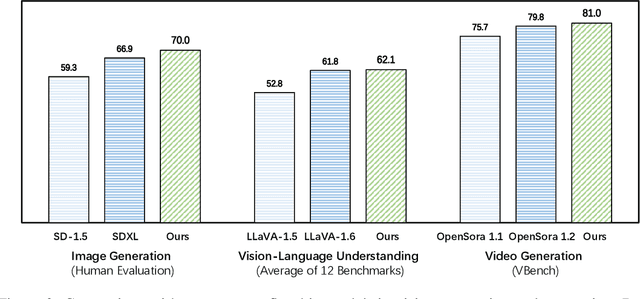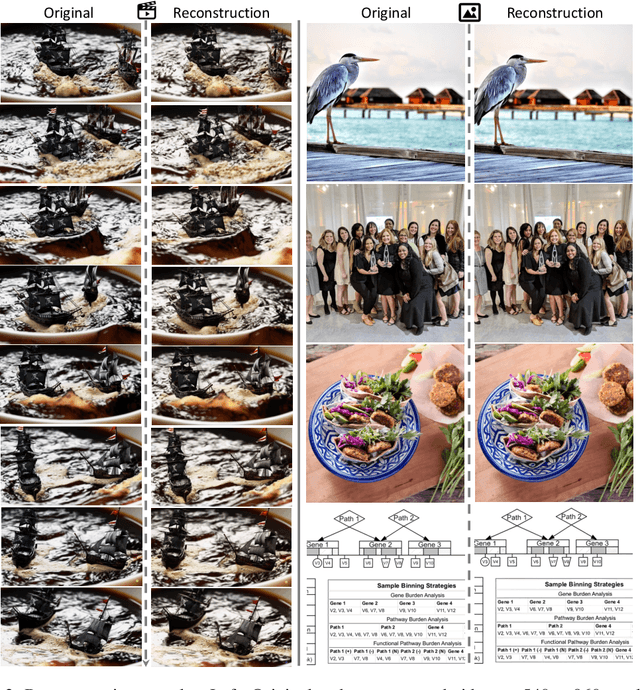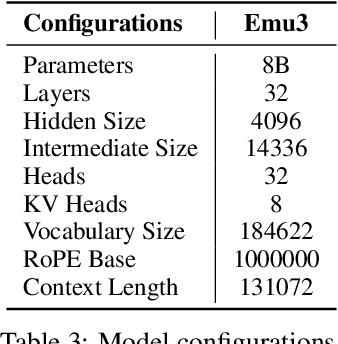Boya Wu
Emu3: Next-Token Prediction is All You Need
Sep 27, 2024



Abstract:While next-token prediction is considered a promising path towards artificial general intelligence, it has struggled to excel in multimodal tasks, which are still dominated by diffusion models (e.g., Stable Diffusion) and compositional approaches (e.g., CLIP combined with LLMs). In this paper, we introduce Emu3, a new suite of state-of-the-art multimodal models trained solely with next-token prediction. By tokenizing images, text, and videos into a discrete space, we train a single transformer from scratch on a mixture of multimodal sequences. Emu3 outperforms several well-established task-specific models in both generation and perception tasks, surpassing flagship models such as SDXL and LLaVA-1.6, while eliminating the need for diffusion or compositional architectures. Emu3 is also capable of generating high-fidelity video via predicting the next token in a video sequence. We simplify complex multimodal model designs by converging on a singular focus: tokens, unlocking great potential for scaling both during training and inference. Our results demonstrate that next-token prediction is a promising path towards building general multimodal intelligence beyond language. We open-source key techniques and models to support further research in this direction.
MLVU: A Comprehensive Benchmark for Multi-Task Long Video Understanding
Jun 06, 2024



Abstract:The evaluation of Long Video Understanding (LVU) performance poses an important but challenging research problem. Despite previous efforts, the existing video understanding benchmarks are severely constrained by several issues, especially the insufficient lengths of videos, a lack of diversity in video types and evaluation tasks, and the inappropriateness for evaluating LVU performances. To address the above problems, we propose a new benchmark, called MLVU (Multi-task Long Video Understanding Benchmark), for the comprehensive and in-depth evaluation of LVU. MLVU presents the following critical values: 1) The substantial and flexible extension of video lengths, which enables the benchmark to evaluate LVU performance across a wide range of durations. 2) The inclusion of various video genres, e.g., movies, surveillance footage, egocentric videos, cartoons, game videos, etc., which reflects the models' LVU performances in different scenarios. 3) The development of diversified evaluation tasks, which enables a comprehensive examination of MLLMs' key abilities in long-video understanding. The empirical study with 20 latest MLLMs reveals significant room for improvement in today's technique, as all existing methods struggle with most of the evaluation tasks and exhibit severe performance degradation when handling longer videos. Additionally, it suggests that factors such as context length, image-understanding quality, and the choice of LLM backbone can play critical roles in future advancements. We anticipate that MLVU will advance the research of long video understanding by providing a comprehensive and in-depth analysis of MLLMs.
Efficient Multimodal Learning from Data-centric Perspective
Feb 18, 2024



Abstract:Multimodal Large Language Models (MLLMs) have demonstrated notable capabilities in general visual understanding and reasoning tasks. However, their deployment is hindered by substantial computational costs in both training and inference, limiting accessibility to the broader research and user communities. A straightforward solution is to leverage smaller pre-trained vision and language models, which inevitably causes significant performance drop. In this paper, we demonstrate the possibility to beat the scaling law and train a smaller but better MLLM by exploring more informative training data. Specifically, we introduce Bunny, a family of lightweight MLLMs with flexible vision and language backbones for efficient multimodal learning from condensed training data. Remarkably, our Bunny-3B outperforms the state-of-the-art large MLLMs, especially LLaVA-v1.5-13B, on multiple benchmarks. The code, models and data can be found in https://github.com/BAAI-DCAI/Bunny.
SVIT: Scaling up Visual Instruction Tuning
Jul 09, 2023Abstract:Thanks to the emerging of foundation models, the large language and vision models are integrated to acquire the multimodal ability of visual captioning, dialogue, question answering, etc. Although existing multimodal models present impressive performance of visual understanding and reasoning, their limits are still largely under-explored due to the scarcity of high-quality instruction tuning data. To push the limits of multimodal capability, we Sale up Visual Instruction Tuning (SVIT) by constructing a dataset of 3.2 million visual instruction tuning data including 1.6M conversation question-answer (QA) pairs and 1.6M complex reasoning QA pairs and 106K detailed image descriptions. Besides the volume, the proposed dataset is also featured by the high quality and rich diversity, which is generated by prompting GPT-4 with the abundant manual annotations of images. We empirically verify that training multimodal models on SVIT can significantly improve the multimodal performance in terms of visual perception, reasoning and planing.
 Add to Chrome
Add to Chrome Add to Firefox
Add to Firefox Add to Edge
Add to Edge